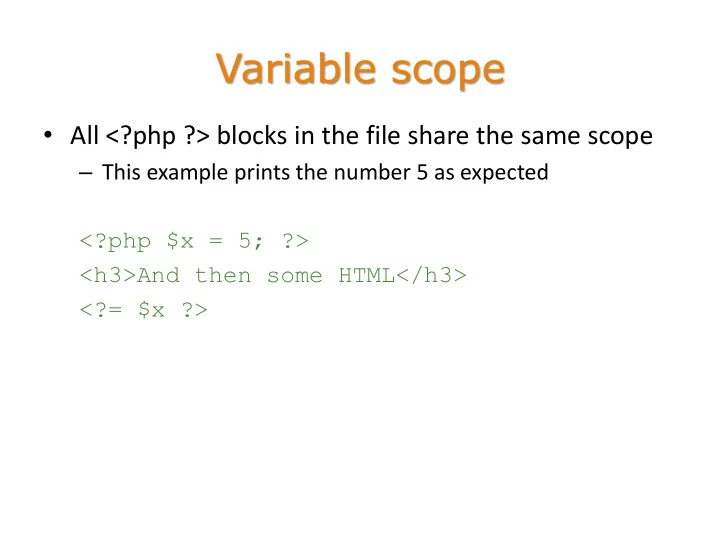

Variable scope • All <?php ?> blocks in the file share the same scope – This example prints the number 5 as expected <?php $x = 5; ?> <h3>And then some HTML</h3> <?= $x ?>
Defining functions • PHP functions follow c-style syntax – But with no explicit types function pythagorean( $s1, $s2 ) { return sqrt( $s1*$s1 + $s2*$s2 ); } – No explicit parameter or return types – No return statement implies a return of NULL
Calling functions • PHP function calls follow c-style syntax $s3 = pythagorean( $s1, $s2 ); – Number of parameters must match – Types are not enforced (obviously) • Functions have global scope – Can be called from anywhere – Should be defined at the top-level of the file – Do not have to be defined before they are called
Default parameter values • Function parameters may be given default values function makecoffee($type = "cappuccino") { return "Making a cup of $type.\n"; } echo makecoffee(); # Making a cup of cappuchino. echo makecoffee(null); # Making a cup of . echo makecoffee("espresso"); # Making a cup of espresso. – Only rightmost parameters can be default
Pass by reference • PHP defaults to pass-by-value • Pass by reference is supported function add_some_extra( &$string ) { $string .= 'and something extra.'; } $str = 'This is a string, '; add_some_extra( $str ); echo $str; # This is a string, and something extra. – But really only makes sense when using classes
Global variables • Variables are assumed to exist in the scope they are used – There’s no declaration to say otherwise function example() { print $a; # will always print NULL } • To access a global variable, it must be declared as such $a = 15; function example() { global $a; print $a; # will print 15 }
Includes • The include and require functions insert the contents of the specified file at that point – Which are then interpreted right there include( “login.php” ); require( “header.php” ); • Using include/require encourages modularity – Put common functions in included files – Put header/footer/sidebar code in included files • Commonly, use include_once / require_once to avoid the same file being included twice – Like the include guard problem in C++
Client-side redirects • Asks the client to request a replacement page • Send an HTTP header via PHP – PHP: header("Location: http://google.com"); • Or directly in HTML – <meta http-equiv=" refresh“ content="0;url=http://google.com/">
Recommend
More recommend